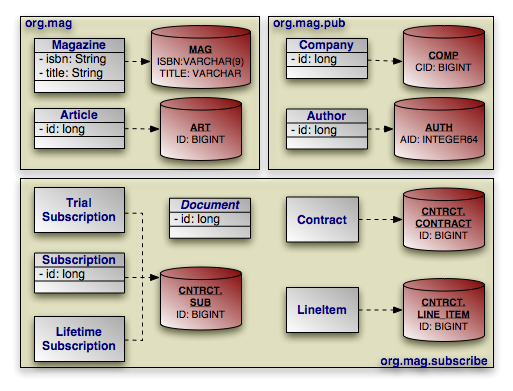With our new knowledge of columns, we can map the identity fields of our
entities. The diagram below now includes primary key columns for our model's
tables. The primary key column for Author uses
nonstandard type INTEGER64, and the Magazine.isbn
field is mapped to a VARCHAR(9) column instead of
a VARCHAR(255) column, which is the default for string
fields. We do not need to point out either one of these oddities to the JPA
implementation for runtime use. If, however, we want to use the JPA
implementation to create our tables for us, it needs to know about
any desired non-default column types. Therefore, the example following the
diagram includes this data in its encoding of our mappings.
 |
Note that many of our identity fields do not need to specify column information, because they use the default column name and type.
Example 13.3. Identity Mapping
package org.mag;
@Entity
@IdClass(Magazine.MagazineId.class)
@Table(name="MAG")
public class Magazine {
@Column(length=9)
@Id private String isbn;
@Id private String title;
...
public static class MagazineId {
...
}
}
@Entity
@Table(name="ART", uniqueConstraints=@Unique(columnNames="TITLE"))
public class Article {
@Id private long id;
...
}
package org.mag.pub;
@Entity
@Table(name="COMP")
public class Company {
@Column(name="CID")
@Id private long id;
...
}
@Entity
@Table(name="AUTH")
public class Author {
@Column(name="AID", columnDefinition="INTEGER64")
@Id private long id;
...
}
@Embeddable
public class Address {
...
}
package org.mag.subscribe;
@MappedSuperclass
public abstract class Document {
@Id
@GeneratedValue(strategy=GenerationType.IDENTITY)
private long id;
...
}
@Entity
@Table(schema="CNTRCT")
public class Contract
extends Document {
...
}
@Entity
@Table(name="SUB", schema="CNTRCT")
public class Subscription {
@Id private long id;
...
@Entity
@Table(name="LINE_ITEM", schema="CNTRCT")
public static class LineItem
extends Contract {
...
}
}
@Entity(name="Lifetime")
public class LifetimeSubscription
extends Subscription {
...
}
@Entity(name="Trial")
public class TrialSubscription
extends Subscription {
...
}
The same metadata for Magazine and Company
expressed in XML form:
<entity class="org.mag.Magazine">
<id-class class="org.mag.Magazine.Magazine.MagazineId"/>
<table name="MAG"/>
<attributes>
<id name="isbn">
<column length="9"/>
</id>
<id name="title"/>
...
</attributes>
</entity>
<entity class="org.mag.pub.Company">
<table name="COMP"/>
<attributes>
<id name="id">
<column name="CID"/>
</id>
...
</attributes>
</entity>